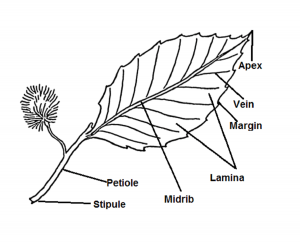Table of Contents
NCERT Class 6 Science Chapter 7 Exercises question Answer
1. Correct the following statements and rewrite them in your notebook
(a) Stem absorbs water and minerals from the soil.
(b) Leaves hold the plant upright.
(c) Roots conduct water to the leaves.
(d) The number of petals and stamens in the flower is always equal.
(e) If the sepals of a flower are joined together, its petals are also joined together.
(f) If the petals of a flower are joined together, then the pistil is joined to the petal.
Answer: a) Root absorbs water and minerals from the soil.
b) Stem hold the plant upright.
c) Root conduct water to stem or Stem conduct water to the leaves.
d) The number of petals and stamens in the flower is NOT always equal.
f) There is no such relation.
2. Draw (a) a leaf, (b) a taproot and (c) a flower.
Answer:

Answer: There are many plants which have long but weak stem we call such plants climber. They come under the herb category. Common examples are:
Money plant, Pumpkin, watermelon, cucumber, betel (pan) etc.
4. What is the function of a stem?
Answer: Stem provides support to the plant. It also transports food material and water.
5. Which of the following leaves have reticulate venation?
Wheat, tulsi, maize, grass, coriander (dhania), China rose
Answer: A venation is the arrangement of veins in a leaf.
Wheat, maize and grass have parallel venation while Tulsi, coriander and China rose have reticulate venation.
6. If a plant has fibrous root, what type of venation do its leaves have?
Answer: Parallel venation, e.g. Maize.
7. If a plant has leaves with reticulate venation, what kind of roots will it have?
Answer: Fibrous roots, e.g. Wheat.
8. Is it possible for you to find out whether a plant has taproot or fibrous roots by looking at the impression of its leaf on a sheet of paper?
Answer: Yes, plants with parallel venation in leaf have taproot while plants with reticulate venation have fibrous root. For more details See activity 9 of the same chapter 7.
9. What are the parts of a flower?
Sepals: Green coloured outer part which protects the flower.
Petal: Coloured part which protects the inner part of the flower.
Stamen: Male reproductive part of the flower. It bears anther which we also call pollen grain.
Pistil: It is the female reproductive part of the flower. I contain ovule.
10. From the following plants, which of them have flowers?
Grass, maize, wheat, chilli, tomato, tulsi, peepal, shisham, banyan, mango, jamun, guava, pomegranate, papaya, banana, lemon, sugarcane, potato, groundnut
Answer: Here all are examples of a flowering plant.
Hint: If you can see or find seed, or fruit in a plant then the plant is a flowering plant.
Grass has tiny seeds which are edible. Maize and wheat plant contain seed. Chilli, tomato bear fruits which contain seed. Shisham has a yellow flower. Jamun, guava, pomegranate, papaya, banana, and lemon are fruits. Groundnut is a seed.
11. Name the part of the plant which produces food. Name the process.
Answer: Leaves of a plant uses carbon dioxide, water and energy of sunlight and make their own food. We call this process Photosynthesis.
12. In which part of a flower, you will find the ovary?
Answer: Pistil. See question 2 diagram.
13. Name two plants in which one has joined sepals, and the other has separate sepals.
Answer: Joined sepals: Datura, Hibiscus (Arhul), Pumpkin, Tomato.
Separate sepals: Rose, lotus.